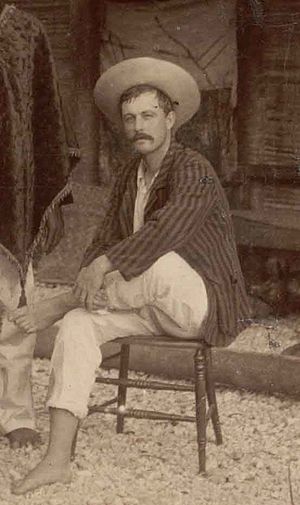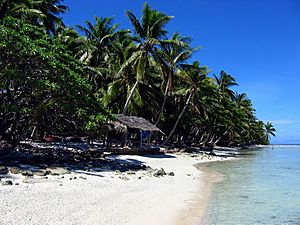Jack Buckland facts for kids
Quick facts for kids
John Wilberforce Buckland
|
|
|---|---|

Buckland in May 1890
(photo by R. L. Stevenson and L. Osbourne) |
|
| Born | 1864 Sydney, Australia
|
| Died | 1897 |
| Other names | Tin Jack |
| Occupation | Island trader |
| Parent(s) | William Wilberforce Buckland and Harriet Emmeline Hopkins |
John Wilberforce "Jack" Buckland (1864–1897) was an adventurous trader who lived in the South Pacific in the late 1800s. People also knew him as "Tin Jack". He traveled with the famous writer Robert Louis Stevenson. Jack's exciting stories about being an island trader inspired a character named Tommy Hadden in Stevenson's book, The Wrecker (1892).
Contents
Jack Buckland's Early Life
Jack Buckland was born in 1864 in Sydney, Australia. He was the first child of William Wilberforce Buckland and Harriet Emmeline Hopkins. His mother, Harriet, was born in Sydney in 1842. Her father, John Hopkins, was a "ship chandler," which means he sold supplies to ships.
When Harriet was young, her father died. His business partner, John Carr, and his wife Eliza adopted Harriet. Jack's father, William, was from England. He worked as a merchant and shipbroker in Australia.
In 1863, William married Harriet in Sydney. Jack was born the next year. When Jack was nine, his family moved back to England. Jack stayed in Sydney with John and Eliza Carr, who adopted him as their son. So, John Carr was like a stepfather and step-grandfather to Jack.
The Carr family lived in a house called "Neepsend" in North Sydney. Later, they sold part of this property. The money from this sale helped John Carr provide Jack with an allowance. John Carr passed away in 1881. The money from the property sale was put into a special fund, and Jack received money from it every year.
In 1883, Jack was living on his own. He visited his parents and siblings who were living near London, England. After that, he returned to Sydney. He then started working for a company called Henderson and Macfarlane in Auckland, New Zealand. He worked as a "copra trader," buying and selling dried coconut meat.
Life as an Island Trader
From the mid-1880s to about 1891, Jack Buckland worked as a trader on Nonouti atoll in Kiribati. Back then, Kiribati was known as the Gilbert Islands. In the 1890s, he traded on Niutao and Nanumea in Tuvalu, which was then called the Ellice Islands.
Jack's main income was about £700 a year from the fund set up by John Carr. This money allowed him to live comfortably in Sydney for part of the year. To earn more, Jack worked as a trader in the central Pacific. This was a very lonely life, as he was often the only European person on a Pacific atoll.
As a trader for a company, he bought "copra" (dried coconut flesh), "sharks fin," and "sea cucumbers." These items were then sold in Asia. He also sold things like tobacco and other European goods to the islanders.
Jack chose this isolated life as a trader. He was not a "castaway" (someone shipwrecked) or a "beachcomber" (someone who lives simply on the beach). Many people in the 1800s chose to escape their normal lives and live in the Pacific islands.
Voyage on the Janet Nicoll
Jack Buckland would sometimes take a break from his lonely island life. He would go to Sydney and enjoy himself, spending his money quickly. One writer described him as spending "a short period each year in Sydney playing spendthrift... and the rest of the year vegetating penniless as a petty trader out in the islands."
In April 1890, Jack was a passenger on a trading ship called the "Janet Nicoll." The ship left Sydney for a trading trip around the central Pacific. The famous writer Robert Louis Stevenson, his wife Fanny Vandegrift Stevenson, and her son Lloyd Osbourne were also on board. Fanny Vandegrift Stevenson kept a journal of the trip, which was later published as The Cruise of the Janet Nichol.
Fanny explained that Jack was called ‘Tin Jack’ because it was the island way of saying ‘Mr Jack’. Fanny also wrote about a time when Jack accidentally caused a fire on the Janet Nicoll. In Auckland, New Zealand, Jack bought ten pounds of "calcium fire" (fireworks). He also bought cartridges, grease paint, a fake nose, and a wig to entertain the islanders at his trading post.
However, after leaving the harbor, the "calcium fire" suddenly caught fire. The fireworks exploded in bright flashes, putting the ship in danger. Luckily, the crew quickly put out the fire.
Tin Jack and the Character of Tom Hadden
Robert Louis Stevenson said that Jack Buckland was the inspiration for the character of Tom Hadden in his book The Wrecker (1892). Stevenson wrote this book with Lloyd Osbourne.
Jack Buckland also received a special mention in Stevenson's book Island Nights' Entertainments, published in 1893. This collection of short stories is dedicated to Jack Buckland, Ben Hird (who managed the ship's cargo), and Harry Henderson (a partner in the company that owned the Janet Nicoll). A character called ‘young Buncombe’, who was inspired by Jack Buckland, also appears briefly in chapter 2 of The Beach of Falesá.
Jack Buckland stayed at Vailima, Stevenson's home in Samoa, in 1894. He stayed with Robert and Fanny Stevenson for three weeks. Stevenson later wrote to a friend, Lieutenant Eeles, saying how happy he was that Eeles had met Jack Buckland:
"But the best part was your meeting with Burn [Jack Buckland]. We know him very well; he is our close friend and the real person who inspired Tommy Hadden! You are right: Tommy is truly 'a good chap,' even though he is very funny."
While The Wrecker was not a huge success, Stevenson's use of Jack Buckland as a character helped describe a special time when Europeans were exploring the Pacific. One writer said that Stevenson's book showed a world of travel, new things, and people who felt a bit lost.
Sixty-five years after The Wrecker was published, an episode of the TV show Maverick (1957) featured a character based on Buckland.
Tin Jack and Vailima, Samoa
Letters from Robert Louis Stevenson in January 1894 also mention that Jack Buckland visited Vailima, Samoa. He came with his "avaga" (a Niutaoan word meaning 'married one') named Meri Matavaka. She was from the Luaseuta family of Niutao. They stayed at Vailima for three weeks. Jack Buckland was still there on February 6, 1894. During his visit, Jack Buckland was mentioned as being friendly with Addie (Adelaide), the daughter of Henry Clay Ide, who was an American judge in Samoa.
Around 1895, Jack Buckland became the island trader on Nanumea in Tuvalu. However, Meri Matavaka did not want to move to Nanumea. The stories from the Luaseuta family say that Jack Buckland left Meri Matavaka in Sydney, Australia. Her father traveled from Niutao to bring Meri back home. Meri Matavaka later became the "avaga" of Fred Whibley.
The End of Tin Jack's Life

Robert Louis Stevenson used parts of Jack Buckland's life to describe Tom Hadden in The Wrecker. He wrote that Hadden was "heir to a considerable property, which a prophetic father had placed in the hands of rigorous trustees." This means Hadden inherited a lot of money that was managed by strict people.
Sadly, Tin Jack's life ended in 1897. A simple story about his death, published in 1913, said he was killed by an explosion on Suwarrow Island. However, Fanny Stevenson's journal, published in 1914, gave a different reason. She wrote that the person managing Jack's money stole all of it.
Fanny wrote: "Some years ago when Jack was at his station he received word that his trustee, who was in charge of his property, had levanted it all. Whereupon poor Jack put a pistol to his head and blew out what brains he possessed." She also described him as a "beautiful creature, terribly annoying at times, but with something childlike and appealing." Fanny said he was very proud of being the real ‘Tommy Hadden’ from Stevenson's book and carried the book everywhere.

